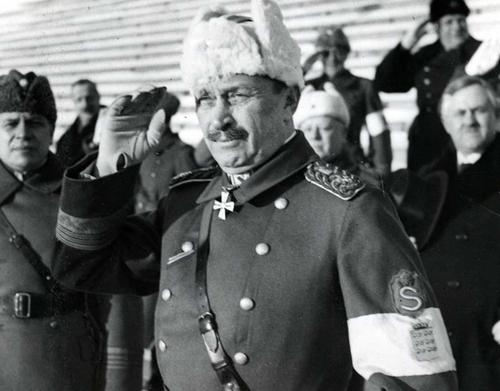Monday 26 February 1940
 |
| Soviet soldiers investigate a Finnish Vickers 6-ton tank. |
Today is the Battle of Honkaniemi, the only Finnish tank attack of the Winter War.
Winter War Army Operations: Finns of the 23rd Division, II Corps have spent the night traveling to the little town of Heponotko, which is about 3 km from the train depot in Honkaniemi. By 04:00, they are in position. The 4th Armoured Company, composed of 13 Vickers 6-ton tanks, has traveled 50 km during the same time and meet them there 30 minutes later. During the journey, the 4th Armoured lost 5 of its 13 tanks due to engine failures and the like.
Captain I. Kunnas is in charge. He orders an artillery barrage and splits his remaining tanks between each flank. The artillery, though, aims short and hits the Finnish troops, causing 30 casualties.
The Finns advance, but are quickly stopped by the Soviet forces. The Finnish tanks prove completely ineffective, being targeted by much larger Soviet T-26 and T-28 tanks as well as 45 mm anti-tank guns. The Finnish tanks did make it to the Soviet line but were quickly knocked out there.
By 10:00, Captain Kunnas received orders to retreat. The Soviets reported to headquarters that they had destroyed six Finnish tanks with no losses to their own tank force.
Winter War Peace Talks: The Finnish Foreign Minister returns to Stockholm for more talks with Madame Kollontai.
Battle of the Atlantic: The 83,700-ton liner Queen Elizabeth departs Clydebank with minimal crew on a top-secret visit to Halifax, Nova Scotia and thence New York. She is one of the few ships to date fitted with a degaussing cable around her waterline to neutralize magnetic mines. Her greatest defense, though, her speed - large liners like her do not travel in convoys.
The British at Gibraltar detain US passenger liner Washington.
Convoy OB 99 departs from Liverpool, Convoy HX 23 departs from Halifax.
European Air Operations: Luftwaffe planes fly over Paris and attract anti-aircraft fire.
British Homefront: Due to naval bases being located in the north of Scotland, the British War Offices announces that commencing 1 March 1940, only those with special passes will be permitted north of the Caledonian Canal.
US Government: Sumner Welles visits with Mussolini and his son-in-law, Foreign Minister Count Galeazzo Ciano, in Rome.
US Military: The War Department creates the Air Defense Command as a component of the US First Army. Its mission is to defend the continental United States against attack.
 |
| A destroyed Finnish Vickers 6-ton tank; behind it is a Soviet T-26. |
February 1940
February 3, 1940: Soviets Capture a BunkerFebruary 4, 1940: Peace Talks in Stockholm
February 5, 1940: Allies to Invade Norway
February 6, 1940: Careless Talk Costs Lives
February 7, 1940: IRA Terrorists Executed
February 8, 1940: Spies!
February 9, 1940: The Welles Mission
February 10, 1940: Confiscation of Jewish Goods
February 11, 1940: Soviets Attack Mannerheim Line
February 12, 1940: Breaches In Mannerheim Line
February 13, 1940: Soviets Inching Forward in Finland
February 14, 1940: Soviets Batter Mannerheim Line
February 15, 1940: Finns Retreat
February 16, 1940: Altmark Incident
February 17, 1940: Manstein and Hitler Discuss Fall Gelb
February 18, 1940: Operation Nordmark
February 19, 1940: King Gustav Says No
February 20, 1940: Falkenhorst Commands Weserubung
February 21, 1940: Radar Advances
February 22, 1940: Friendly Fire
February 23, 1940: Soviets Present Their Demands
February 24, 1940: Fall Gelb Revised
February 25, 1940: Mr. Welles Comes to Visit
February 26, 1940: Battle of Honkaniemi
February 27, 1940: Finns Retreat Again
February 28, 1940: Overseas Volunteers Help Finland
February 29, 1940: Finns Accept Soviet Terms In Principle
2020




